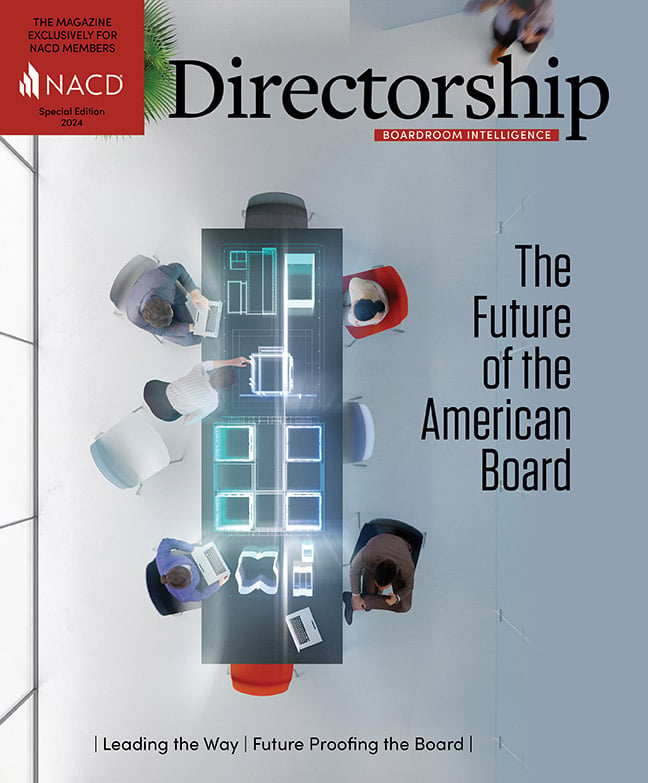The nature of life and work has changed drastically since early 2020, with stakeholders becoming increasingly socially conscious, technological advances disrupting careers and industries, and more. In a world that seems less governable from a societal perspective, corporate governance has become even more important. The NACD initiative on The Future of the American Board identified 10 core principles of good governance that can help boards guide their organizations toward making the best decisions for the company and for society. There seems to be no better time for championing effective corporate governance than now.
Last year, how many people would have bet on the downfall of one-time wunderkind Sam Bankman Fried and his cryptocurrency exchange FTX, or the collapse of multiple regional banks, including Silicon Valley Bank, a few months later? How many board members could have predicted that the use of artificial intelligence would increase suddenly and exponentially with the release of publicly facing tools in November 2022? How many boards were discussing the potential ramifications of the debt limit crisis that would play out the following spring?
Geopolitical tensions, soaring inflation, supply chain issues, changing workforce dynamics, and more were challenging boards then as well as now. But the problems facing businesses and their boards are only growing more intricate and numerous.
In 2011, NACD published the Key Agreed Principles to Strengthen Corporate Governance for US Publicly Traded Companies, which listed 10 principles that represented the governance best practices of the time. The enormous change that the world of business and beyond has experienced over the past few years called for a reassessment of the way boards approach their responsibilities, leading to NACD’s formation in 2022 of the Future of the American Board Commission.
“Disruptions involving shifting economic conditions, the geopolitical order, advancements in technology, labor market dynamics, supply chains, regulation, climate change, and social and investor activism are reshaping society and are transforming the role of business,” said commission cochair Bill McNabb, former chair and CEO of Vanguard and coauthor of Talent, Strategy, Risk: How Investors and Boards Are Redefining Risks. “The boards of directors who guide corporate activity also need to adapt to assure that corporate governance keeps pace.”
“I would suggest that the work that the Future of the American Board Commission did is actually prescient in some ways given the additional challenges that we have faced,” said Donna F. Zarcone, president and CEO of DF Zarcone & Associates and a director of CDW Corp., Cigna Group, The Duchossois Group, and Quinnox. She is also a member of the Smithsonian National Board.
“The dynamics that the [Future of the American Board] framework talks about … are myriad factors that every company is having to deal with. And they’re having to deal with it in the spotlight, for the most part, and they’re having to deal with it in a way that requires them to move more quickly and with more agility,” said Luis A. Aguilar, former commissioner of the US Securities and Exchange Commission, a board member at Donnelley Financial Solutions and Envestnet, and a principal at Falcon Cyber Investments. “To me, that’s almost a definition of a critical juncture point. The status quo, the way you’ve done things, isn’t really going to work in today’s present and in the future. And the way you go about dealing with it will define whether or not people outside objectively see you as having been on the winning side.”
“It’s an emphasis on a different dynamic for how the engagement should happen,” added Orlando D. Ashford, chief people officer of Fanatics, chair of Perrigo Co., and a director of Array Technologies and Syndio Solutions. “Businesses have always had different challenges to manage…. I just think that the issues are faster pace, more complex, and they anchor a lot on talent, people, [and] culture, and we call it out in ways that we did not in the past.”
Purpose at the Core
The Future of the American Board report centers on such thematic issues perhaps more than the Key Agreed Principles, which focused almost entirely on board operations, and it sets corporate purpose as the overarching principle. But don’t just take the commissioners’ word for the importance of purpose to the future of governance: according to the 2023 NACD Trends and Priorities Survey, 44.1 percent of director respondents said that they expect to see a much stronger focus on corporate purpose in the pursuit of long-term value creation over the next three years. Consider also the Business Roundtable’s “Statement on the Purpose of a Corporation,” issued in August 2019, which emphasized the role of companies as a benefactor to all stakeholders, not just shareholders, and society at large.
“The fact of the matter is, boards need to be much more explicit about having the good fight, about how they are viewing the landscape of stakeholders, and that relates very much to whether we’re going to be more short term or long term about certain issues,” said Linda A. Hill, cofounder of Paradox Strategies, the Wallace Brett Donham Professor of Business Administration at Harvard Business School, and faculty chair of the school’s Leadership Initiative.
“If customers are not happy with your products, they’re not going to buy them. Paying heed to the views of stakeholders is not putting them above shareholders. It’s simply recognizing that they’re an important component of success in any company,” said Aguilar. “And you need to listen to them, you need to pay attention to them. If they’ve got concerns about your operations, you need to sit down and talk with them. You may learn something; they may learn something from you. But ignoring them because you’re so focused on shareholders will ultimately … be detrimental to the value of the company and detrimental to the shareholders.”
Especially post-pandemic, when employees and consumers expect far more from companies, corporate purpose and long-term sustainability are inextricably linked to stakeholder interests. But corporate purpose isn’t just about meeting demands for wider societal consideration and impact. When discussed thoughtfully and laid out transparently, purpose informs company culture as well as the company’s strategy.
“Having companies that are grounded in purpose, an inherent value that’s being delivered behind what the business does, which is a little bit bigger than the simple, ‘Buy this because it’s cool, or use this because you need it or want it’… if we can connect it to a purpose that’s a bit bigger in terms of society or community, we think those businesses have more strength and are sustainable longer,” said Ashford.
“There were some different views on what the hierarchy or the ordering should be of the principles,” said Aguilar. “They’re all interconnected, they’re all interrelated, they’re all important. But no one argued that corporate purpose shouldn’t be at the top…. Corporate purpose as a driver for decision-making is a powerful, powerful tool.”
Board Effectiveness and Culture
That’s not to say the Future of the American Board commissioners sidelined board operations. In fact, about half of the principles deal directly with board functionality.
“The operations of the board are critical, because if you operate well and use your time well, then you can fulfill your responsibilities much more effectively,” Zarcone said.
Defining corporate purpose means nothing if the board cannot learn to work as a team to put that purpose into action. But few boards seem to see themselves as a team.
“At best they’d say, ‘I’m on the team,’ but do we know how to work as a team?” said Hill. “Unless you really work hard at it, that group doesn’t really know each other all that well. One of the things that we do see, they’re not as cohesive. What I mean by that is they don’t interact all that much given the nature of the kinds of decisions they’re supposed to be making…. How much opportunity have they had to build trust?”
Trust, cohesion, and working as a team can foster the right dynamics to allow boards to be agile and innovative in problem-solving, according to Hill. It may seem counterintuitive, then, to say that boards also need what Hill calls “creative abrasion,” but trust should be built among board members with the goal of obtaining the ability to disagree constructively.
“There are so many topics that never get explicitly discussed, and consequently, board members are acting as if they do know what everyone thinks about X, Y, [or] Z,” she said. “And there actually hasn’t been the discussion.”
Having uncomfortable discussions that incorporate diverse viewpoints can be supported by creating psychological safety, or the ability to speak up without fear of retribution or humiliation. “There’s all this writing about psychological safety, but I think we forget that board members don’t feel psychological safety either. How do you help them feel safe enough to say and do what they need to do and say?” Hill said.
“I sometimes joke [that] our discussions are sometimes lumpy, but we know the best decisions, when you’re going through that lumpiness, take effort because you have to create space for the different points of view, for the debate to happen, for there to be some tension,” Ashford said. “Then if you can work through the tension to different perspectives and the debate, you end up with better answers…. So, [be] more conscious about that and lean into the lumpiness or the tension or the disagreement at times to get to the better outcome.”
Diversity and People
Hill sees a lack of explicit and constructive discussion especially about diversity, equity, and inclusion (DE&I). “I don’t know that many boards have any kind of larger discussion about why we’re doing this, what we hope to accomplish, and … if it’s going to work, what do we need to do to help it work,” Hill said. “I think that those discussions are not actually had by the whole board…. It’s not that anyone’s not well intentioned, but you all have your own minds, your own mind-set about what it means to have [it], why we’re doing this, what it’s about. I know that it doesn’t get discussed, so, consequently, we don’t do any work.”
In the 2023 NACD Trends and Priorities Survey, 84.5 percent of respondents said that boards without diversity will be less acceptable in the future, suggesting how imperative it is that boards have discussions about DE&I considering board members and the wider workforce.
“Boardrooms and management teams are having conversations about, ‘Well, what’s our response to this?’ Because if there is a discussion around equal access to all people, that is going to have to come from companies,” said Ashford. “We’re not going to look for the government to legislate equal opportunity because they’re making a decision not to. But then corporations will have to take that off, and that’s boardroom discussion now.”
What can also be difficult for boards to discuss when it comes to talent is how to make trade-offs between disparate groups of stakeholders. Take the example of Target Corp., which made headlines in May after its Pride Month products spurred some customers to confront and even threaten store workers. Ultimately, Target decided to focus on workers’ safety and well-being by removing certain products and moving displays to the back of some stores.
“It really does depend on the organization and what you want to stand for. What does your brand mean? What is your purpose as an organization?” Hill said. “Your role is to set the strategy for how an organization is going to proceed and also to talk and to set the risk framework.”
Different Dynamics in Practice
The report offers not only thematic and operational food for thought, but also a list of questions within each section. Rather than be prescriptive in recommending how boards should use the framework, the commissioners decided to pose questions for boards to discuss in an open-ended way.
“I would print the questions and just hand them out to the board members and ask, ‘Can we answer these questions?’ That’s a way perhaps to get dialogue started,” Aguilar said. “And it may be that they can recognize some or maybe all of the questions that they don’t know enough about the operations of the company or the way it’s being addressed to be able to answer [them].”
Ashford has used the report as a sort of benchmark against which he can assess his boards’ practices. “Most boards go through a process of trying to assess the quality of what [we] do and how we do it, and we’ve been able to pull a few of these principles into those discussions,” he said.
“I would hope that this report would stimulate other directors to look back, for instance, on the last three years, when we’ve all gone through this traumatic time, and use the report and what they actually did to reflect on, say, Are we where we need to be when the next pandemic happens, whatever that ends up being?” Hill said.
The exponential advancement and increasingly connected nature of technology and other issues demanding boards’ attention require a shift in mind-set. It’s never too early to work to be on the winning side. ■






